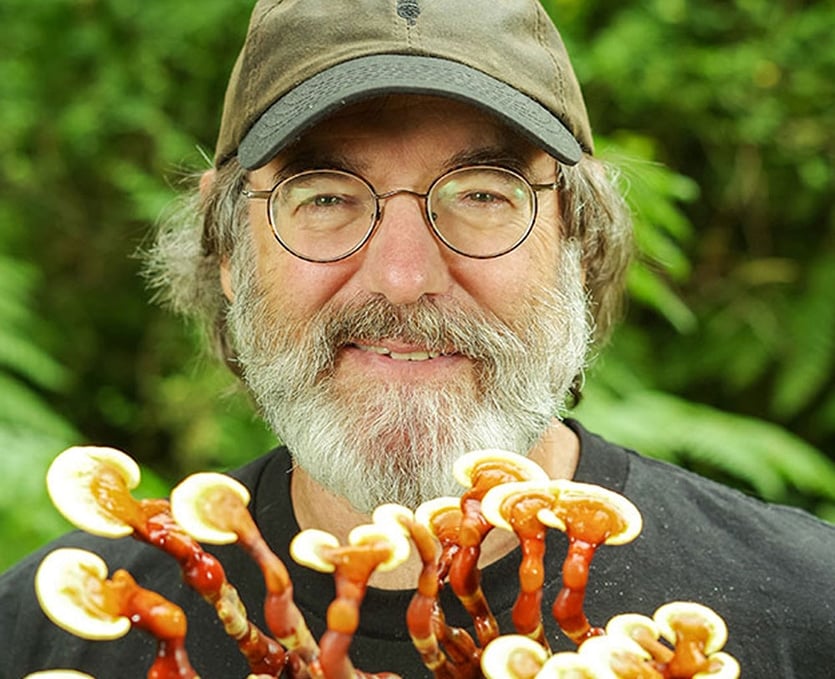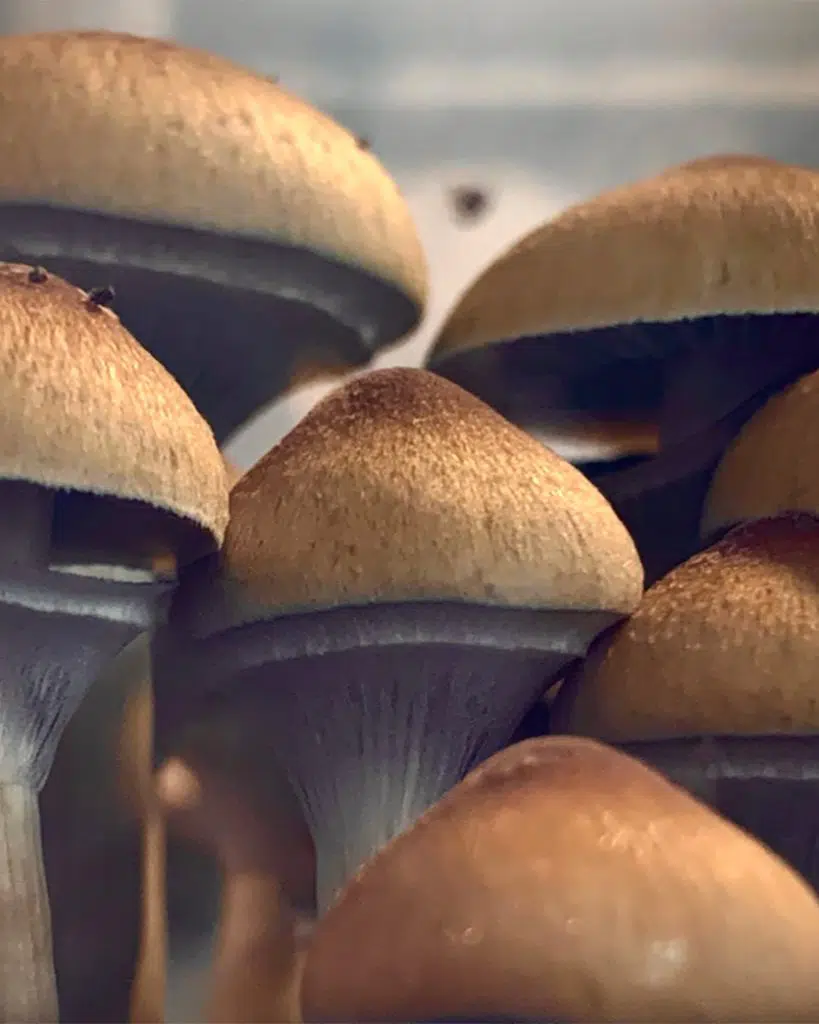The Paul Stamets Microdosing Stack
The Stamets Stack combines three components: A microdose of psilocybin mushrooms along with Lion’s Mane mushroom and niacin. Stamets designed the stack to enhance cognitive function and confer a host of benefits related to neurogenesis—although his hypothesis has not been reviewed by a medical professional nor has the protocol been put to the test in rigorous clinical trials, which are considered best-practice in nutrition science and public health. The claimed benefits of the Stamets Stack include:
- reduced anxiety and depression
- stabilized mood
- enhanced creativity
- regeneration of visual and auditory neurons
- reduced irritability
- relief from PTSD symptoms
- reduced incidence of neuropathy
- increased ability to socialize, empathize, and feel courageous
- mediated effects of aging on the brain
- enhanced self-awareness
- greater sense of interconnection
In essence, the stack is intended as a nootropic (brain-enhancing) protocol that’s meant to help people break free of the habits of their ordinary minds and thereby think in novel, more adaptive ways—ways which, according to Stamets, can spur the evolution of human consciousness. To achieve this, Stamets combines microdose to low-dose psilocybin mushrooms with other potentially synergistic compounds.
Some benefits may be conferred at a microdose level of psilocybin. A microdose of psilocybin is quite different from a low dose. A microdose is sub-perceptual, or below the threshold of intoxication. This micro amount is usually one-tenth of a regular dose and can therefore be consumed while going about daily life. A low dose may cause some perceptible psychedelic effects.

To date, we have limited—but promising—research on microdosing. In a study published in 2013, lab mice who had previously been conditioned into a PTSD-like fear response were able to overcome the learned trauma after ingesting microdoses of psilocybin. A preliminary study from 2019 looked at the benefits and challenges of microdosing and concluded that the area is indeed promising enough to warrant further research.
Anecdotally, a quick search through YouTube videos and psychedelic message boards turns up dozens of first-hand accounts from psychonauts and mental health advocates on the stack’s ability to promote physical health and mental-emotional wellbeing.
What’s in the Stamets Stack?
Some of the particulars of the Stamets Stack have evolved over the last several years, as reflected in Stamets’ various patent applications. Overall, Stamets believes that the components of the stack work better together, citing a possible entourage effect from the compounds similar to the one hypothesized for cannabis.
GET OUR VERSION OF THE STAMETS STACK TO TAKE ALONG SIDE YOUR MICRODOSE CAPSULE
Lion’s Mane Mushrooms
Lion’s Mane (hericium erinaceus) is a large, puffy, white-colored mushroom that’s nicknamed the “bearded tooth fungus.” In Japan—where it was purportedly used by Buddhist monks—it bears the name the “mountain priest mushroom.” The mushroom is known to support brain health by stimulating nerve growth factor (NGF), which prompts the production, growth, and maintenance of neurons. Because neurons tend to stagnate and atrophy with age, Lion’s Mane has interesting potential as an anti-aging supplement. Research shows that it may help slow or prevent dementia. Stamets has called Lion’s Mane an “intelligence mushroom,” which he believes may actually make us smarter.

Lion’s Mane—which may also have anti-inflammatory and heart-health benefits—is fully legal, relatively inexpensive, and can be found in natural food stores and online. Incorporating it as part of the Stamets Stack protocol may boost and enhance the long-term benefits of psilocybin, the formula’s most celebrated ingredient. In fact, Stamets referred to Lion’s Mane as the “second smart mushroom,” while delivering the keynote address at the 2020 Bioneers Conference. It’s bested only by psilocybin itself, he claims, emphasizing the importance of Lion’s Mane to this nootropic stack because it “reinforces psilocybin’s ability to occasion neurogenesis.”
Stamets notes that Lion’s Mane products made from mycelium (the plant’s underground components), instead of the aboveground portion known as the fruiting body, may be most beneficial.
Read: Long-Term Effects of Microdosing
Psilocybin Mushrooms
Of the 100-plus varieties of psilocybin mushrooms—also known as “magic mushrooms,” or simply, “shrooms”—psilocybe cubensis is the most common. Psilocybin is the primary psychedelic compound found in magic mushrooms, although the compound itself is not psychoactive. Rather, psilocybin is converted into the more active compound psilocin by the human liver. The latter molecule is responsible for mushrooms’ mind-bending effects. Regardless, psychoactive mushrooms have a long history of human use; they were used as a spiritual aid in pre-Columbian cultures throughout the Americas. Additionally, the speculative “stoned ape hypothesis,” suggests that early hominids in Africa ate psilocybin mushrooms that engendered a rapid brain expansion, which in turn contributed to the evolution of homo sapiens.

Johns Hopkins University studied psilocin for its potential in helping resolve end-of-life depression and anxiety. A newly published study also shows significant improvement in people with major depression after only two therapeutic psilocybin sessions. Other research indicates that psilocin may also play a helpful role in treating addiction to alcohol and tobacco—with an impressive 60 percent of participants remaining tobacco-free after 12 months in the latter study. The compound is known to substitute for serotonin, the most prominent neurotransmitter, which is related to its role in helping to relieve depression and anxiety.
Much of the attention around psilocybin’s therapeutic properties centers on macrodosing—large doses of dried mushrooms in the two to five-gram range. For the Stamets Stack, however, Paul Stamets recommends using a microdose to a low dose of psilocybin: 0.1 to one gram. A low dose (0.5 to 1 gram) may inspire some perceptual psychedelic effects. As such, it is not recommended to take this dosage during a workday or when you have pressing responsibilities. Regardless, Stamets has high hopes for the therapeutic and human potential of the psychedelic, stating that naturally-derived psilocin makes you “smarter, kinder, and more courageous.”
Some prefer microdosing psilocybin. A microdose is often just 0.1 to 0.2 grams of dried mushroom. Although, it is important to note that the dosage can vary significantly, depending on a variety of factors like body weight, the type of mushroom consumed, et cetera. Some consumers may find that dosages up to 0.5 grams are considered a microdose. Although, the higher the dosage, the more likely you are to experience mild to strong psychedelic effects.
Niacin
Niacin (vitamin B3) is alternately known as nicotinic acid. Its main physiological role is in helping your body convert the calories in the food you eat into usable energy. It also plays a role in the health of your nervous system, digestive system, and skin. The vitamin may also enhance the uptake of psilocybin when used in the Stamets Stack—as suggested by Stamets Stack proponents.
When taken in the quantity recommended in the Stamets Stack protocol (100 to 200 milligrams), niacin will produce an uncomfortable flush effect characterized by redness and tingling in the face, neck, and arms that may last from ten to 30 minutes. Flushing is caused by the vasodilative properties of niacin. The skin turns red as more blood flows into the capillaries. Temporary sensations of heat, itchiness, and discomfort may accompany this effect. The niacin flush is both a harmless side effect of larger doses; for the purposes of the protocol, avoid the “no-flush” variety of the vitamin.

Because of niacin’s role as a vasodilator, it’s believed to distribute the benefits of psilocybin more thoroughly through the entire body, including to the nerves at the end of the peripheral nervous system—where, according to Stamets, the majority of neurogenesis actually happens. Niacin also carries GABA (a neurotransmitter that plays a role in regulating fear and anxiety) across the blood-brain barrier. Stamets states in a 2018 patent application that its presence in the stack “enhances the neurogenic benefits” of psilocybin. Because of its initially uncomfortable flushing side effect, niacin’s final purpose as part of the Stamets Stack is to deter overuse.
Be aware that the recommended daily allowance (RDA) of niacin is 14 to 16 milligrams, and that the stack calls for a much higher dose. Research suggests that, in healthy adults, Niacin is unlikely to be toxic unless taken in high doses—upwards of 2,000 mg a day. Although, as mentioned in a patent from Stamets, medical professionals may monitor patients taking more than 500 milligrams each day. The adage “start low, go slow, stay low” is well-matched with niacin and this protocol; high dosages are a likely culprit for potential unwanted side effects.
Warning: Those with preexisting conditions including, but not limited to, liver or kidney disease, b3 vitamin sensitivity, alcoholism, and potential pharmaceutical interactions should consult a medical professional before taking large doses of niacin.
Stamets Stack Dosages
Paul Stamets recommends different dosage ranges for each element included in the Stamets microdosing stack. The following guidance is based on a 154-pound (74-kilogram) person:
- Psilocybin mushrooms: 0.1 to 1 gram dried mushrooms (with likely perceptual effects nearing 0.5 grams and up)
- Lion’s Mane: 5 to 20 grams fresh (or 50 to 200 milligrams of extract containing erinacines and hericenones)
- Niacin: 101 to 200 milligrams
In part, dosage should be determined by body weight; people weighing less than 154 pounds should start on the lower side of the scale, while those weighing more than 154 pounds may benefit from a dose closer to the high end of the recommended range. In any case, it’s a good idea to start low with any psychedelic substance in order to get to know your body’s receptivity to the compounds and their effects on you. It should also be noted that natural variabilities exist in the psilocybin content of mushrooms—some are more potent than others—and these differences can be further complicated by how the mushrooms were grown and stored.
The Paul Stamets Microdosing Protocol
The Stamets Stack is associated with two, slightly varied, microdosing schedules. In Stamets’ first appearance on the Joe Rogan Experience in 2017, he recommended a repeating regimen consisting of five days of microdosing followed by two days off. In 2019, his advice had shifted to reflect a four days on/three days off model. In either case, taking two to three days per week off from the stack anecdotally reduces tolerance from psilocybin.
Accounts also vary in terms of recommended duration of the nootropic stacking routine; some microdosers and psychonauts continue the 5:2 or 4:3 schedule for prolonged periods—even indefinitely—while others discuss using the stack for a month at a time before taking a longer tolerance reset of two to four weeks.
Other Microdosing Protocols
The Stamets Stack can be contrasted with another well-established microdosing protocol developed by James Fadiman. Fadiman introduced his own microdosing protocol in his 2011 book, The Psychedelics Explorer’s Guide. The Fadiman protocol, touted for promoting productivity, focus, and emotional regulation, involves microdosing a psychedelic compound every fourth day. Developed for LSD, Fadiman’s protocol has been expanded to include psilocybin.
The Hammer Stack: GET OUR VERSION OF THE STAMETS STACK TO TAKE ALONG SIDE YOUR MICRODOSE CAPSULE
(This side-stack contains no illegal substances or psilocyn1n which may be unlawful in your area)
Looking for a fully infused 🍄 capsule? Join our Patreon for a GREATLY expanded menu selection


